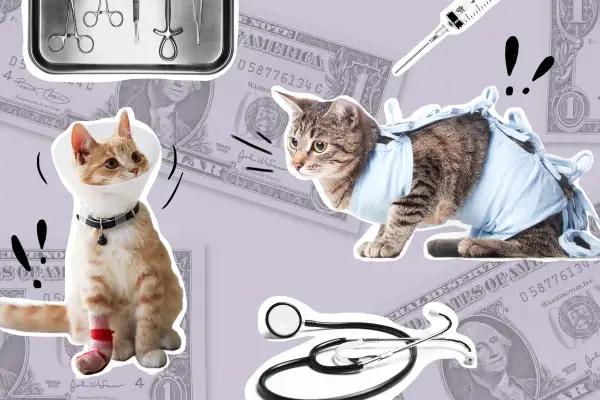More People Are Buying Pet Insurance, and It's Driving Prices Down

Good news has been in short supply lately when it comes to the costs of medical care for dogs and cats. But now there are signs that the premiums for pet insurance are trending down. That could change the math on whether to get or keep this health coverage for your pooch or kitty.
The change in premiums isn’t a huge one. But it comes after steady rises in the typical cost of vets bills and pet insurance premiums. Now, according to the Kansas City, MO-based trade group North American Pet Health Insurance Association (NAPHIA), the average cost of insuring a pet cat against accident and injury has gone down, changing from $349 a year in 2019 to $341 in 2020.
Premiums for dogs didn’t get cheaper between 2019 and 2020, but they rose at a much more modest rate than for any other year since at least 2016, according to NAPHIA. Between 2018 and 2019, the annual premium increase for insuring an average dog was $26.47. From 2019 to 2020, the same number went up by just $8.75—about a third of the previous year’s hike.
Advisor Smith, an industry research group, posted data that agreed with the overall trend NAPHIA documented. It also showed continuing wide differences from company to company in the cost of insurance.
“New pets are the reason” average premiums have moderated, says Rick Faucher, CEO and cofounder of The Connected Pet Company and president of NAPHIA. “We’ve seen double-digit growth in gross written premiums, which have increased by 25.5%, as well as double-digit growth in the number of pets insured, which grew by 22.5%. When a market expands that quickly, you see a unit cost flattening, because you have a larger pool to spread the risk.”
Here’s more about the numbers and what they mean if you’re considering starting a policy on your pet, or wondering whether to continue one you already have.
More affordable pet insurance may continue
Enough other factors are at play in pet insurance prices that Faucher says it’s difficult to know if the 2020 figures represent a trend. Still, it’s possible that prices will continue to head down, he says.
One reason is that the pool of insured pets may continue to expand. Even with strong growth in the number of pets insured, just 2.5% to 3% of companion animals have health insurance through NAPHIA member companies, Faucher says. That leaves a lot of room for the industry to grow, which could bring premiums down further. Competition could also mean lower pricing. “If companies are looking to buy market share, you may see the average premium go down,” he adds.
Then there are the coming changes in how pet insurance is regulated and sold, which could further moderate prices. A new model law regulating the pet insurance industry is under construction, and it may ultimately mean that consumers see a more standardized product when they buy health insurance for their pets. But that law is 18 months to three years from fruition, Faucher estimates.
A stronger case for insuring a pet?
The promise of lower premiums is good news for any type of insurance. But they’re especially welcome for coverage, like pet insurance, that pays out only in rare instances in which the very worst happens.
A Money analysis concluded that pet insurance makes sense financially only if and when your dog or cat develops a serious condition in which you rack up vets bills in the thousands, or even tens of thousands, of dollars. And such a payoff is most likely if you insure your pet for years, so as to be insured before such a disease develops -- and a ban on coverage of pre-existing conditions kicks in to prevent you from getting a policy.
Pet insurance premiums are a relatively hefty expense. On average, you’ll pay around $700 a year to insure a dog, and $350 or so to cover a cat. Even a moderation of the premium hikes of recent years could result in spending hundreds of dollars less over your pet’s lifetime than might have been the case. And that in turn could reduce the sting of having pet insurance that rarely if ever pays out, as our analysis suggests will be the case for most dog and cat owners.
Shopping around matters more than ever
Even if pet premiums continue to soften, big gaps in costs from company to company persist, and may even be growing, data from the 2021 Advisor Smith survey suggests. The company priced premiums for comparable coverage in a single city for both a sample dog and cat. For cats, the premiums from the priciest companies were more than four times as much as those of the lowest -- a difference of more than $700 a year. Company to company, the premiums for dogs were even more varied -- a range of five times, for an annual cost difference of more than $1,000.
Money, too, found significant differences in cost by company when we similarly surveyed premiums last year, but they were less dramatic than those of Advisor Smith. The gap between the least and most expensive insurers we priced ran to about 100%, for savings of about $180 a year for cats and $360 for dogs for choosing the lowest priced insurer. While coverage we priced in our survey was a bit more similar from company to company than with Advisor Smith, the two surveys suggest it's no less valuable to shop around for pet insurance than it was, and it might be more so.
More from Money:
The Best Pet Insurance Companies of 2021
When Does Pet Insurance Really Pay Off? We Did the Math to Help You Decide
